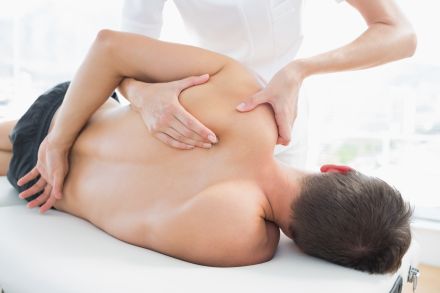
ART® is a patented hands-on soft tissue system/movement-based treatment protocol that identifies and treats scar tissue problems on and in between a patient's muscles and tissues. Some people describe ART® as a deep tissue massage and myofascial release, which treat chronic pain and breaks up scar tissue so that muscles can move more freely. The goal of ART® is to restore optimal texture, motion, and function of the soft tissue and release any entrapped nerves or blood vessels.
ART® was developed, refined and patented by P. Michael Leahy, DC, CCSP, who noticed that his patients' symptoms seemed to be related to changes in their soft tissue, which could be felt by hand. He also noticed that one tissue or structure can affect another structure biomechanically and it can also affect the other structure directly. By observing how muscles, fascia, tendons, ligaments and nerves responded to different types of work, Dr. Leahy was able to consistently resolve over 90% of his patients' problems.
Headaches, back pain, carpal tunnel syndrome, shin splints, shoulder pain, sciatica, plantar fasciitis, knee problems, and tennis elbow are a few of the many conditions that can be resolved quickly and permanently with ART®, because all these conditions typically result from overused muscles and other soft tissue.

Over-used muscles and other soft tissues can result from:
- Acute Conditions (pulls, tears, collisions, etc.)
- Accumulation of Small Tears (micro-trauma)
- Not Getting Enough Oxygen (hypoxia)
- Excessive Friction (occurs in areas of chronic tension, overuse and in fibrotic build-up)
Each of these factors can cause the body to produce tough, dense scar tissue in the affected area, which can bind up and tie down tissues that need to move freely.
Normal muscle acts like a bundle of rubber bands, which are able to shorten and lengthen freely. When a muscle is overused, scar tissue adhesions build up, which cause muscles to become shorter and weaker. Tension on tendons causes tendonitis, and nerves can become trapped, which can cause a variety of symptoms, including reduced range of motion (ROM), loss of strength, pain or chronic tightness. If a nerve is trapped the patient may also feel tingling, numbness, and weakness.
The vast majority of patients are referred by medical doctors, nurses, chiropractors and other health professionals. ART® Performance Care is unique in the healthcare industry because it allows an athlete to have his or her performance evaluated, biomechanically, and corrected through treatment.
Treatment will also typically include exercise, especially for patients who have been immobilized or who lack flexibility, strength or endurance to increase their flexibility and range of motion. More advanced exercises may also be incorporated to focus on improving strength, balance, coordination and endurance.
A multitude of musculoskeletal conditions are successfully treated with ART®, including:
- Carpal tunnel and other peripheral nerve entrapments
- Spinal pain and dysfuntion
- Tendonitis and other soft tissue inflammatory disorders of the hand, wrist, elbow, shoulder, hip, knee, ankle, and foot
- Sciatica, TMJ, recurrent sprains and strains
What is an ART® treatment like?
First, ART® certified physical therapists use their hands to evaluate the texture, tightness and movement of muscles, fascia, tendons, ligaments and nerves. Then, the therapist will treat abnormal tissues by combining precisely directed tension with one or move of 500 specific movements to identify and correct the specific problems affecting each patient.
Does ART® hurt?
Treatment can be uncomfortable at times, during the process of breaking up adhesions but this pain will subside immediately after completion of a treatment session. It is not uncommon to experience a duplication of symptoms during the treatment as well. This is actually an indication that the primary cause has been identified.
Can ART® help pain referral from trigger points?
Yes, trigger points are tender spots in muscles that cause you to feel referred pain. For example, a trigger point in your piriformis muscle, a deep muscle in your glutes, will tell your brain that there is a problem in your glute that runs down the back of your leg into your foot. Where it hurts may not necessarily be where the problem is. However, by correcting the muscle function, the trigger point goes away and so does the pain referral.
What is a soft tissue injury?
Most injuries are primarily soft tissue in origin. Some examples of
soft tissue injuries that are successfully treated by ART® include:
- Achilles Tendonitis
- Ankle Injuries
- Back Pain
- Compartment Syndrome
- De Quervain's Tenosynovitis
- Foot Pain
- Plantar Fasciitis
- Frozen Shoulder (Adhesive Capsulitis)
- Golfer’s Elbow
- Tennis Elbow
- Hand Injuries
- Headaches
- Hip Pain
- Iliotibial Band Syndrome (IT Band Syndrome)
- Knee Pain
- Leg Injuries
- Neck Pain
- Repetitive Strain Injuries (Cumulative Trauma Disorders)
- Rotator Cuff Syndrome
- Running Injuries
- Shin Splints
- Shoulder Pain
- Tendonitis
- Throwing Injuries
- TMJ
- Whiplash
- Wrist Injuries
What is a peripheral nerve entrapment?
A peripheral nerve entrapment is a nerve that is stuck within soft tissue outside the central nervous system (e.g., the brain and spinal cord). Many times the ART® Long Tract Nerve Entrapment Protocols will resolve such conditions as:
- Disc Herniations
- Sciatica
- Carpal Tunnel Syndrome
- Thoracic Outlet Syndrome
- Cervical Brachial Syndrome
- Radial Nerve Entrapments (Radial Tunnel Syndrome)
- Ulnar Nerve Entrapments (Handle Bar Palsy)
- Grip Weakness
- Femoral Nerve Entrapments
What is an adhesion?
Our bodies contain special protein structures called connective tissue, also know as fascia. This substance connects each part to other parts and the whole, very much like a flexible skeleton. When this tissue is healthy it is smooth and slippery, allowing the muscles, nerves, blood vessels or organs to move freely and function properly. An adhesion, also known as fibrosis, is a band of scar tissue that binds two parts of tissue or organs together. It may appear as a thin sheet of tissue similar to plastic wrap or as a thick fibrous band that attaches to muscles, nerves and lymph, decreasing their ability to work properly.
Will stretching get rid of adhesions?
Not until the dysfunction within the soft-tissue structures have been correctly released by a physical therapist who will find the origin of the problem, perform ART® treatments, and provide functional training, teach the patient proper stretching techniques as well as teaching the patient necessary behavioral modifications to prevent future injuries. Adhesions are much stronger than normal healthy tissue. So, when an individual performs a stretch, the tissue that lengthens is not the adhered tissue but the healthy tissue. Stretching before the adhesions are properly released can actually cause more damage to healthy tissue resulting in the increase of adhesions.
Are there any contraindications for Active Release Techniques?
ART® is not appropriate in cases of blunt trauma or active inflammation. Otherwise there are no serious contraindications for its use, though treatments should be limited to every other day.
Only health care providers with a license to treat soft-tissue injuries or conditions can become certified in ART® and treat patients. We are ART® certified. Let us help. You do not need a prescription in order to be treated using the ART® technique.
